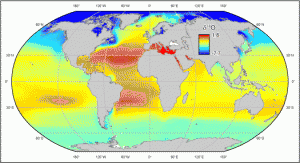Stable isotopes have become an indispensable tool for understanding natural and anthropogenically-influenced systems. Isoscapes (isotope landscapes) are spatially explicit predictions of elemental isotope ratios within a geospatial framework. Large databases of spatially explicit isotopic data and new data analysis tools have presented new opportunities to exploit spatiotemporal isotopic variability as a source of information on the connectivity, variability, and sensitivity of ocean ecosystems to change. Earth scientists have long recognized and capitalized on natural, spatial variability in the isotopic composition of environmental materials, particularly in the terrestrial realm. Conversely, the extent of the world’s oceans and complexity of processes influencing baseline food web isotope values has meant that our understanding of ocean isoscapes has not yet caught up to our terrestrial counterparts. This project is part of an ongoing collaboration to construct ocean isoscapes at a range of spatial and temporal scales. This project has a number of components, including the collection and analysis of empirical data on stable isotope distributions in marine systems, the development of ocean biogeochemical models to accurately predict isotope spatial distributions, and the refinement of geospatial statistics to improve the generation of ocean isoscapes. For students interested in learning more about isoscapes and geospatial statistics, I highly recommend looking into the SPATIAL Summer Short Course at the University of Utah.
Primary Collaborators: Dr. Simon Thorrold (WHOI), Dr. Gabe Bowen (Univ. of Utah)
Publications
